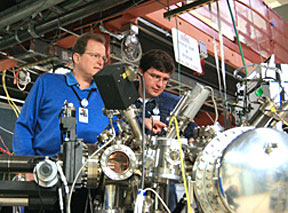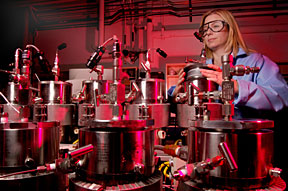| Research
|
In mid-2008, the Large Hadron Collider at the European laboratory CERN will accelerate its first beam of protons, ringing in a new era in particle physics research. From extra dimensions of space-time to the nature of dark matter to the origin of mass, scientists expect that the LHC will provide answers to some of the greatest mysteries in science. Kaori Maeshima, of the Department of Energy's Fermi National Accelerator Laboratory, has worked on the Compact Muon Solenoid experiment at the LHC for many years. In January, the U.S. CMS collaboration appointed Maeshima as its Operations Coord/inator. "The CMS detector parts have been built in many different places in the world and brought together to the CMS experimental hall. Now is the time to learn how to operate CMS as one experiment," she said. More than 1,000 scientists from 93 U.S. universities and national laboratories have contributed to the construction of the LHC and its six experiments. Maeshima has helped to establish the LHC Physics Center at Fermilab. In her new role she works closely with the commissioning team at CERN to get the CMS experiment ready for recording collisions. Fortunately, she and her colleagues in the United States can carry out much of their work without having to travel to Europe . From Fermilab's Remote Operations Center they can monitor the status of the LHC accelerator and the CMS experiment in real time. Prior to working on the CMS operation, Maeshima led the design and operation of the online monitoring system of another particle physics experiment, the Collider Detector at Fermilab. Her CDF experience has been extremely valuable for her CMS work, she said. Maeshima's goal for her new job is simple. She wants to make the remote monitoring operation from Fermilab seamless and as good as the one from the CMS control room at CERN. She expects that Fermilab's Remote Operations Center will be a prime location for scientists to witness the first LHC collisions later this year. "I'm looking forward to working with everyone,” she said. “This is a very exciting time in particle physics.” Submitted by DOE's Fermi National Accelerator Laboratory |
|||||||||||||||||||||||||||
|
Check out the joint Fermilab/SLAC publication symmetry.
|
The march of the
|
 |
|---|
The work of Anders Nilsson (left) and Anton Nikitin might pave future directions for alternative energy research. |
Researchers at the Stanford Synchrotron Radiation Laboratory, located at DOE's Stanford Linear Accelerator Center, have surpassed by a surprising margin the Department of Energy's goal for storing hydrogen within a unique material called carbon nanotubes. The pioneering result, published in the American Chemical Society's Nano Letters, brings us one step closer to realizing hydrogen as a source of energy.
"We are trying to find a way to make hydrogen-power affordable," graduate student Anton Nikitin said. "Current vehicle prototypes cost over two million dollars. Sustainable developments will rise only from examining this problem piece by piece."
Hydrogen—the most abundant element in the universe—is an attractive carrier of renewable energy. It can be used in fuel cells to produce electricity, with the only byproduct being water. However, developing safe and efficient methods of storing hydrogen remains a challenge.
Current methods for storing hydrogen are expensive and inefficient. Storing hydrogen in tanks made from costly composite materials requires dangerously high pressures of up to 10,000 pounds per square inch. Compressing hydrogen is expensive, and the energy required outweighs the benefits.
Nikitin and his colleagues were able to pack seven percent by weight hydrogen into carbon nanotubes through the formation of bonds with carbon atoms. The chemically grown nanotubes are made of pure carbon and have walls a single atom thick. Because single-walled nanotubes are essentially all surface area, they can theoretically store an enormous proportion of hydrogen, making it a promising storage medium.
Demand for carbon nanotubes—in fields ranging from electronics to medicine—adds to the excitement surrounding this material, but don't expect hydrogen energy to appear overnight. Associate Professor Anders Nilsson estimates that it will be 20 years before all of the pieces come together.
The world is possibly facing the biggest challenge of modern civilization," Nilsson said, "and science plays a pivotal role in developing a long-term solution."
Submitted by DOE's Stanford Linear Accelerator Center




